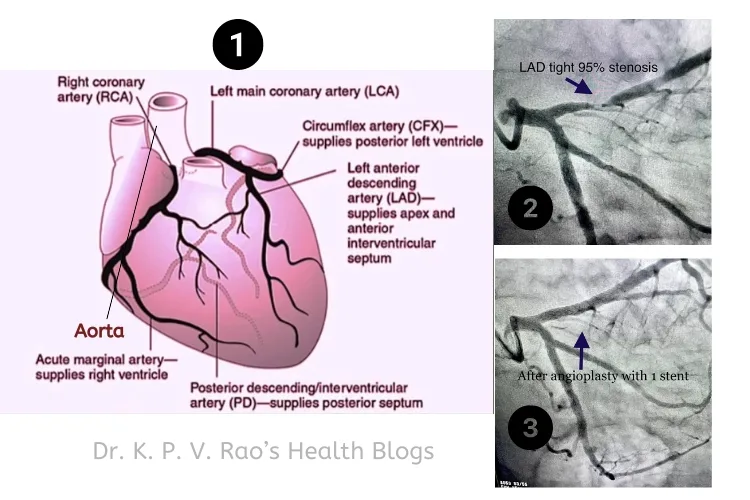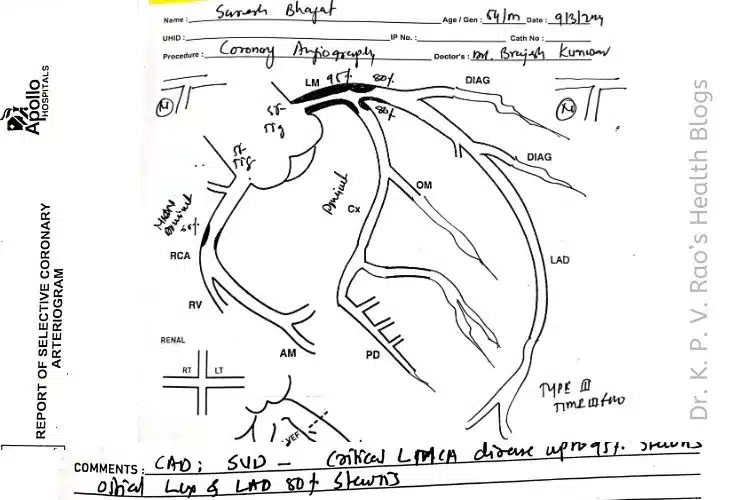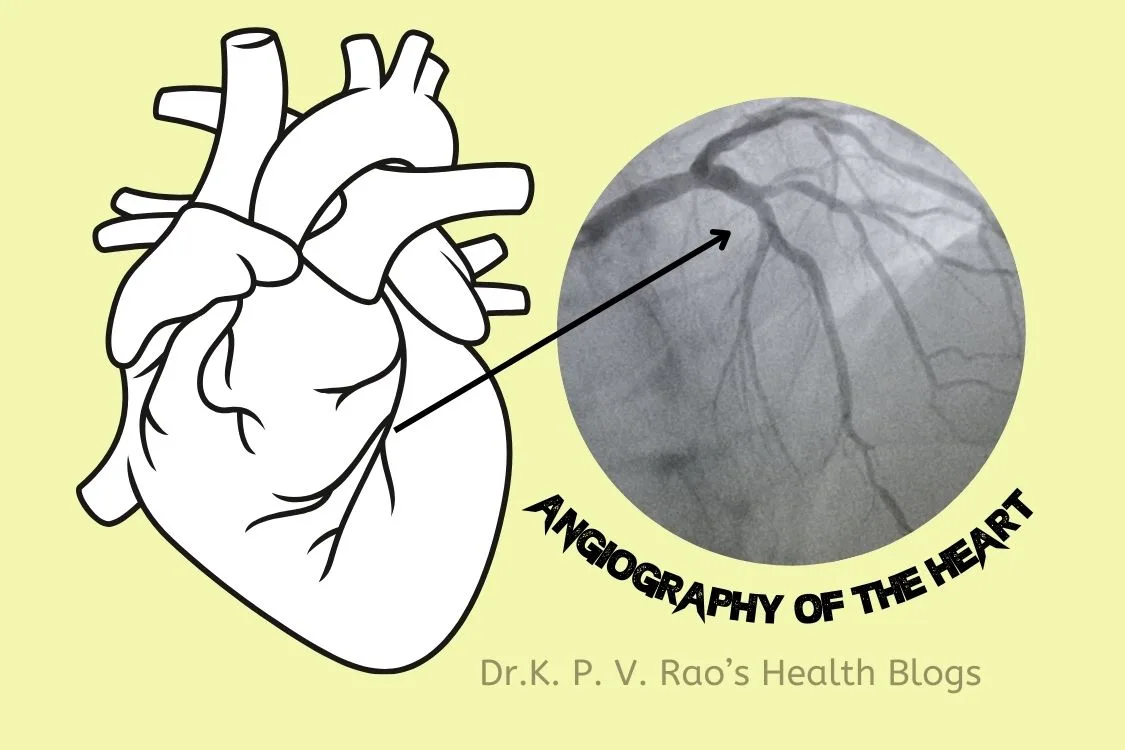Procedure, Indications, After-Effects, and Other Applications
Indroduction
Let’s imagine someone close to you is having chest pain. He is taken to the hospital emergency room where a doctor examines him and after preliminary examination tells his colleague or junior “Let’s get his angio done”.
This word “ angio” is a short form for the word angiography. This word is derived from two words– angio, meaning a blood vessel and graphy, meaning a picture or image. In other words, angiography simply means an image of a blood vessel.
But it does not end here- the imaging is done by X-ray and plain X-ray does not show up blood vessels. So, to get a picture of this blood vessel, mostly of an artery anywhere in the body, your doctor injects a chemical called contrast dye into the blood vessels and then takes an X-ray. This X-ray picture is called Angiography, and angio of the heart arteries is called coronary angiography.
What is Angiography of the Heart?
The health of our heart is maintained by blood vessels called coronary arteries; these arteries can be seen on an X-ray plate by a special procedure after injecting a contrast dye into it and this procedure is called angiography of the heart.
The importance of Heart Angiography
To understand the importance of heart angiography, let’s learn it with an example-a real time case study:
Case study
In March 2024, one evening as I was about to close my clinic, one of my patients, Suresh Bhagat, a 54-year-old middle-aged man, visited the clinic with a complaint of uneasiness and heaviness in the chest. He was quite confused why this was happening because he had never been on any sort of treatment for health problems like diabetes or hypertension till now.
I could sense the anxiety on his face. On examination, his heart was racing, his BP was slightly raised and his pulse a bit irregular. I immediately referred him to the emergency room of a local hospital where they had ICU facilities. They immediately got an ECG done where they found him having a heart attack. He was advised an angiography which he refused; so, he was admitted in the ICCU of the hospital. Next day he was discharged and visited my clinic again with the reports.
After going through his reports, I suggested him book an appointment with Dr. Brajesh Kumar Kunwar, a renowned cardiologist in Navi Mumbai. Dr. Brajesh went through his reports and suggested an angiography that he got done at the Apollo Hospital in Navi Mumbai. [The picture below is the actual photo shot of heart angiography of Suresh Bhagat [No.2]; the next picture- No. 3- is of another patient with a similar problem who had angioplasty with a stent done]

2 & 3: Images provided by Dr. Brajesh Kumar Kunwar
The angiogram of the heart revealed an almost complete [95%] block in the left main coronary artery. Have a look at the diagram below for more clarity-

Dr. Brajesh then suggested that Suresh should get a bypass surgery [CABG] done to avoid a fatal outcome of a second heart attack. Suresh got it done the very next day and now he is hale and hearty.
So, you see, this investigation helped save this patient’s life. Hope you have understood the importance of this valuable investigation. Now, let’s learn further how getting heart angio done helps the patient and his doctor-
How does heart angiography help a patient and his/her doctor?
Angiography of the heart, also known as coronary angiography, as said earlier, is a specialized diagnostic procedure designed to visualize the coronary arteries.
This medical technique plays a crucial role in the detection and management of coronary artery disease (CAD). It is a vital diagnostic procedure employed by cardiologists to see the coronary arteries and determine the presence of blockages or other abnormalities
Coronary angiography is very useful in the field of cardiac or heart care. It assists in:
- evaluating chest pain,
- diagnosing unexplained heart failure, and
- investigating abnormal results from other tests like stress tests or echocardiograms.
By offering a clear and precise picture of the coronary arteries [as shown above], angiography helps in making informed decisions about the most effective treatment strategies.
Moreover, it provides a roadmap for interventional procedures such as angioplasty and coronary artery bypass surgery, ensuring that treatments are targeted and efficient.
Earlier, I had written an article on coronary artery bypass surgery. If you have not read it yet, you can read this article here-
The significance of angiography extends beyond mere diagnosis. It facilitates immediate treatment during the same session, such as balloon angioplasty or the placement of stents to restore proper blood flow.
What does Angiography do?
Coronary angiography is a vital procedure for diagnosing conditions like atherosclerosis and planning appropriate interventions. It provides a clear view of the coronary arteries, enabling informed decisions on treatment strategies.
Angiography allows for immediate treatment during the same session, such as balloon angioplasty or stent placement [also called angioplasty or PTCA– I will discuss about this in my next article] , restoring proper blood flow. This procedure plays a pivotal role in modern cardiology, aiding in timely diagnosis and offering a gateway to immediate therapeutic interventions.
What are the indications for getting a heart angiogram done and how is it done
Let’s now learn why coronary artery angiography is done and how it is done. Please go through this PDF I have attached below to learn about this procedure in detail-
Other Applications of Angiography
Beyond heart disease assessments, angiography is a versatile diagnostic tool with numerous applications across various medical fields. Here are some other uses of this procedure-
- Cerebral angiography is employed to visualize blood vessels in the brain.
- Renal angiography focuses on the arteries supplying the kidneys.
- Peripheral angiography is used to examine blood vessels in the limbs, particularly useful for patients experiencing pain of peripheral artery disease (PAD), especially in legs.
The ability to pinpoint vascular issues accurately makes angiography an indispensable tool in modern medicine, facilitating timely and targeted interventions across a broad spectrum of health conditions.
Conclusion
Overall, angiography’s diagnostic capabilities extend far beyond the heart, underscoring its pivotal role in various medical specialties.
Its detailed imaging of blood vessels ensures precise diagnosis, guiding effective treatment plans and improving patient outcomes.
As with any procedure, understanding the potential after-effects and ensuring proper post-care can significantly enhance recovery and overall health.
Useful articles links:-
- https://en.m.wikipedia.org/wiki/Angiography
- https://www.nhs.uk/conditions/angiography/#:~:text=Angiography%20is%20a%20type%20of,doctor%20to%20see%20any%20problems.
Final Words
I hope you have now understood what angiography means and how an angigram of the heart is useful in diagnosing heart disease in a patient and help him get treated. Incidentally, this happens to be my 200th article on this website.
Dear reader, your consistent support has brought my website to this level and hope you will continue your support even more going ahead. Let’s make the world a better place to live in by staying informed and staying healthy!
My next article will be on treatment based on information of an angiogram- Percutaneous Transluminal Coronary Angioplasty [PTCA].
My heartfelt thanks to Dr. Brajesh Kumar Kunwar for providing the inputs for this article through the images shown above.
Do share this article on your social media groups and through Twitter [now X.com] by clicking below-
Understanding Angiography of the Heart Share on XYou can share your thoughts about this article in the comments section below; you can also get notified about my future articles by clicking the bell icon you see at the righthand side bottom of the article.
Adios.

